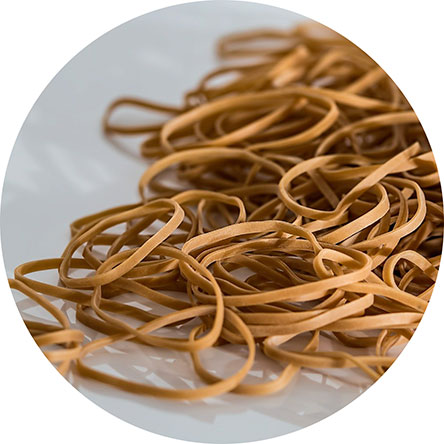



 |
|||||||||
| Just about everyone has used rubber bands, but few people have taken the time to observe the less obvious properties of these everyday objects. In this activity you will examine the thermal properties of rubber, that is, the behavior of rubber as it relates to heat, a form of energy. | |||||||||
| In the first experiment you will attempt to detect heat flow into or out of a rubber band. To do this, you need a rather sensitive heat detector. Fortunately, you have such a detector with you at all times. Surely, you've felt the heat of a flame or the cold of an ice cube. Therefore, you know that your skin is sensitive to heat flow. In this experiment, you will detect heat flow using some of your most sensitive skin, that on your forehead or on your lips. | |||||||||
|
|||||||||
| An object feels cool or cold to you when heat flows from your skin to the object. Conversely, an object feels warm or hot when heat flows from the object into your skin. If the stretched rubber band feels cool, then it absorbs heat from your skin. If it feels warm, then it gives off heat to your skin. If the band feels neither warm nor cool, then there is no detectable heat flow. These three cases can be represented as follows: | |||||||||
|
|||||||||
| Which of these three cases best describes what you observed? | |||||||||
| There is another way to test which of the three statements is correct. We can see what happens to the length of a rubber band if we heat or cool it. | |||||||||
|
|||||||||
| Does this observation agree with what you found in the first part of the experiment? Doing an experiment several ways and checking for agreement in the results is an important strategy in science. | |||||||||
| When rubber is heated it behaves differently than most familiar materials. Most materials expand when they are heated. Consider the liquid in a thermometer. The thermometer works because the liquid expands when its temperature increases. Similarly, a wire made of metal, such as copper, becomes longer as it gets hotter. The expansion of metals with increasing temperature is the principle behind the functioning of home thermostats and of jumping discs. | |||||||||
Whether a material expands or contracts when it is heated is mainly a due to the structure of the molecules it is made of. When energy is added to a material, it is distributed throughout the material and, on average, each atom or molecule will have more energy and will be moving more energetically than it was before the energy was added. In materials made up of small, compact molecules, e.g., the liquid in a thermometer, as the molecules move about more, they push their neighboring molecules away. Rubber, on the other hand, contains very large, threadlike molecules. When rubber is heated, sections of the molecules move about more vigorously. In order for one part of the molecule to move more vigorously as it is heated, it must pull its neighboring parts closer. To visualize this, think of a molecule of the stretched rubber band as a piece of string laid out straight on a table. Heating the stretched rubber band causes segments of the molecules to move more vigorously, which can be represented by wiggling the middle of the string back and forth. As the middle of the string moves, the ends of the string get closer together. In a similar fashion, the ends of the rubber molecules get a bit closer as the rubber is heated, causing the stretched rubber band to contract. |
|||||||||
 |
|||||||||
| After Prof. Shakhashiri demonstrated this experiment in one of his live shows, one attendee sent him this picture. "The kids grabbed rubber bands as soon as they got home, to experience the warmed-when-stretched phenomenon." |
| For additional information, see CHEMICAL DEMONSTRATIONS: A Handbook for Teachers of Chemistry, Volume 1, by Bassam Z. Shakhashiri, The University of Wisconsin Press. |